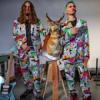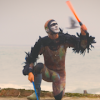
There have been numerous retellings of the myth of Orpheus and Eurydice, but none, perhaps, is as decidedly hip and provocative as Lyra, an hourlong fusion of dance, music, and film from San Francisco experimental duo The Living Earth Show (TLES) and the envelope-pushing Post:ballet. Landing at Stanford Live Jan. 18–20, Lyra, which premiered in 2021, takes a deep dive into questions regarding empathy, technology, and our relationship to the natural world.
A sonic and visual feast, the production features music by Samuel Adams, who was awarded a 2019 Guggenheim Fellowship to create this work and who composed TLES’s first-ever commission in 2010, the year that electric guitarist Travis Andrews and percussionist Andy Meyerson formed the duo. In addition, Vanessa Thiessen made the fascinating site-specific choreography, captured by Benjamin Tarquin’s striking cinematography and danced by members of Post:ballet, the company established by Robin Dekkers in 2009.
For the San Francisco-based Meyerson, 37, who grew up in Baltimore and went to Stanford University and the San Francisco Conservatory of Music (SFCM), the score for Lyra — a cool blend of repetitive phrases, jazz riffs, EDM, and thrash-fueled ambient sounds — feels like the DNA of the work.
Meyerson explained: “Our job as [TLES] is to turn the question of classical music on its head, the way one is taught to approach the field as an interpreter of new music. When you commission [a work], you’re making history. … In the mid-2010s, what felt important to us was to confront and interrogate the classical tradition as best we could.
“[To] engage with [a story as frequently] told as Orpheus felt like an important challenge to us to end that traditional classical framework [and] to see if we could create something in response to the world,” added Meyerson. “What does it mean for Claudio Monteverdi’s [operatic setting of Orpheus] to show up in a manner that’s synthesized in the way that sounds are created and generated [and] how contemporary sonic worlds are built? How can it be useful in the most ambitious and uncompromising musical statement?”
Enter, then, composer Adams, a colleague of Meyerson’s since the two met at Stanford. “We were there together,” said the percussionist, “and [though] I went on to [SFCM] and he went to Yale, we were always good friends. We grew up together, not just personally but artistically. His work is astonishing; it’s brilliant in so many different ways.
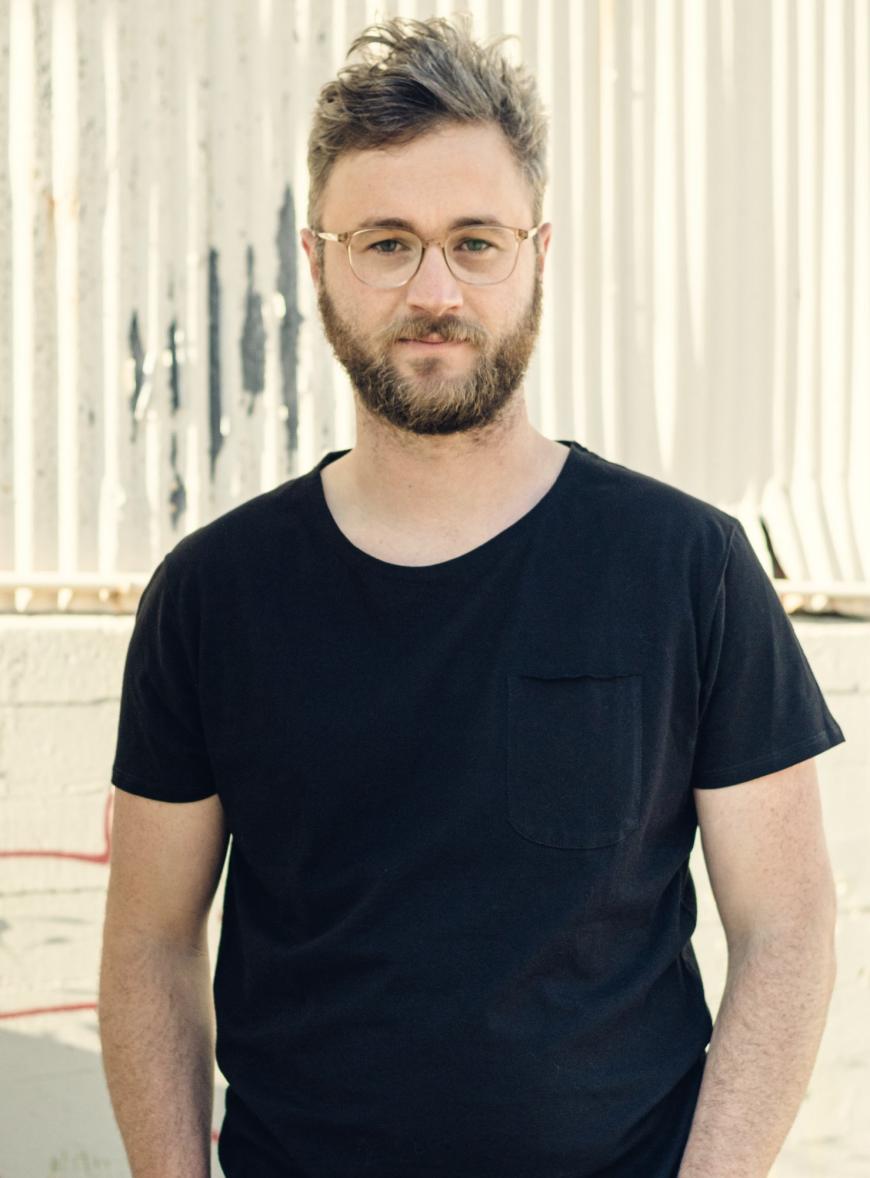
“His ear is so singular,” added Meyerson, who is also music director of Post:ballet, “and so are his attention to craft and detail and integration of electronics, [as well as] his knowledge of form and structure. We worked together and collaborated for years and years, at the same time [that TLES] also worked with Post:ballet.”
As to the other half of TLES, Andrews, 40, said that he met Meyerson at SFCM, where he was struck by the percussionist’s “energy. He was always working on these insane transcriptions of music in the cafeteria. We never played music together until after we graduated. Andy dreams big. I call him an ideas person and mean it.
“He wanted to put people together to have a conversation about classical music,” said the guitarist, who grew up in Wisconsin and lives in the Bay Area. “We didn’t play together in grad school, [but] I knew of him, and he was good about being a part of the scene and building the scene.”
And what a scene the duo has built. Deemed “outstanding” by the San Francisco Chronicle and one of The Washington Post’s “22 for ’22 composers and performers to watch,” TLES has created a slew of wild, wonderful, and occasionally wacky works and projects. Among them are Sonic Biogenesis: Genomics and Mutant Jungles (2020), featuring Guillermo Galindo’s “genome scores,” and Squeeze! Squeeze! Squeeze! (2012). The latter, an evening-length opera/meditation on the 94th chapter of Herman Melville’s Moby-Dick, was composed by Luciano Chessa and performed on a yacht in the San Francisco Bay, where audience members were served coffee and tins of sardines.
And though there will be neither fish nor fishmongers in Lyra, the work comes from the same ideological place: that of collaborative artistic endeavor, with contemporary classical music, visual design, and yes, even fashion all part of the performance mosaic. Post:ballet’s Dekkers, 39, who has been working with TLES since 2016 — when they first collaborated on Do Be, which featured original scores by five composers, including Pulitzer Prize finalist Christopher Cerrone — explained the collaborative ethos: “What drew me to [TLES] was that they approach music the same way I approach dance.
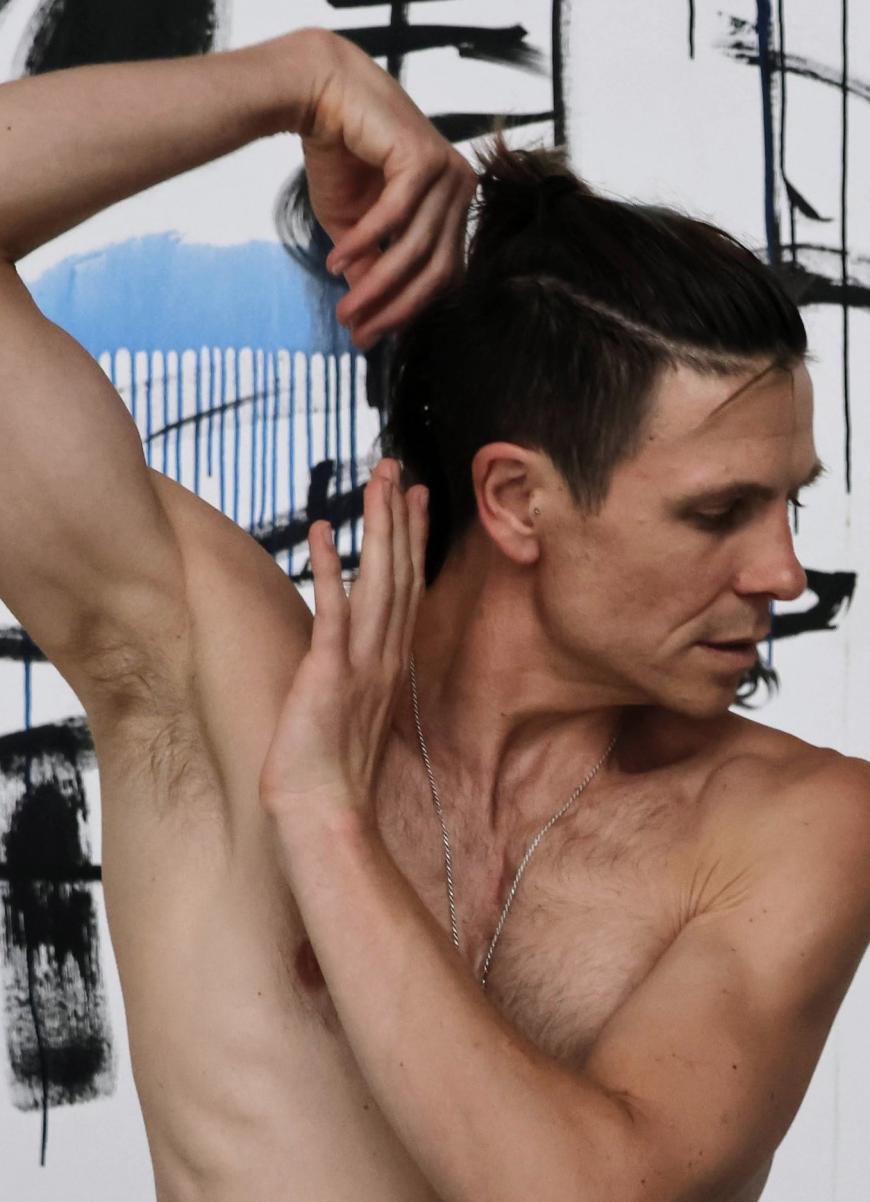
“They believe in finding artists they trust and admire and give them carte blanche to create what it is that inspires them,” added Dekkers, whose troupe is known for broadening ballet’s aesthetic reach. “I work in the same way, with dancers and choreographers I trust, supporting them and their vision. We’re tasked with not only making the piece but also with lighting design, costumes, raising the money, and doing the contracts.”
Regarding choreographer Thiessen, Dekkers said that it was important to give her “space to make whatever it is that would inspire her. I like supporting people like Vanessa, whom I believe in [and who is] defining the direction concert dance is going. I feel honored to be part of that.”
And part of that — a rather large part — was making the film of Lyra. Because the work was begun during the pandemic, the cinematic element was the initial impetus and remains key to the project. According to TLES’s website, Lyra “weaves together the digital and the physical through a seamless, highly collaborative synthesis of dance, projected film, live music, and Meyer Sound’s new spatial sound technology Spacemap Go.”
Meyerson called that technology “the most electronic environment one can experience live music in, which in Lyra includes found sounds from the American West — the desolate parts of it — [as well as] bass, piano, all sorts of synthesized sounds. The sound world is presented as a character here. It’s the third member of the ensemble.”
It was Dekkers who found the spectacular shooting locations for Lyra, including the Alabama Hills. Set between the jagged peaks of the Sierra Nevada and the Inyo Mountains in the Southern California desert, the range is where “a lot of big movies are filmed,” Dekkers pointed out, “[as well as] old westerns, because it looks quintessentially like the old West.”
The locations, however, were not exactly terpsichorean-friendly, with Post:ballet’s 11 dancers deploying Thiessen’s choreography during a three-week camping sojourn across California. In addition to the desert location, sites included the Ancient Bristlecone Pine Forest in the White Mountains in Inyo County.
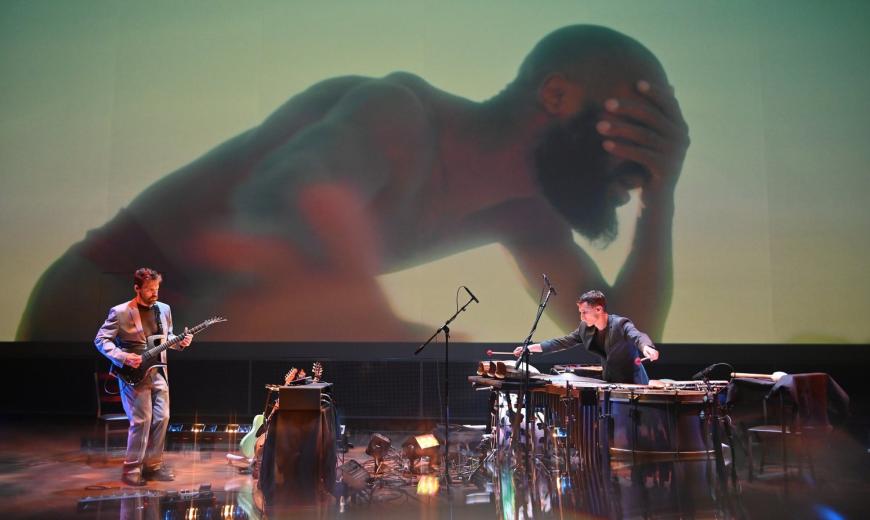
So, the myth of the doomed lovers Orpheus and Eurydice — dancers Babatunji Johnson and Moscelyne ParkeHarrison, respectively — has never looked quite like this before. Eurydice sports hiking boots, while other dancers are seen careening off of boulders, wrestling with one another, and dealing with extreme weather conditions. (Spoiler alert: In the finale, Johnson’s Orpheus is the only dancer who moves from screen to stage.)
Dekkers recalled that the setting for the overworld of the story “was on a friend’s property next to the Tahoe National Forest, and we were able to camp on their land and to film in the forest areas around there. All of those opening forest scenes we filmed at the Yuba River, and the cave scene, Hoyt’s Crossing, was the entrance to the underworld.
“We had to drive there, hike for 30 minutes, ford the river, go through a milelong tunnel to get to the other side,” Dekkers added. “Friends lived there, so I had explored it before. We were on such a tight schedule, and three weeks goes by fast when you’re making a full-length film. Every day we had to travel, and if a dancer had a really big scene, they would have the next day off. [Cinematographer] Ben [Tarquin] was working every day. Even on our day off, he wanted to get underwater shots, so he took Moussey to a river.”
And according to Dekkers, who is also artistic director of Berkeley Ballet Theater, Tarquin not only filmed and edited Lyra but could have been a dancer himself, “leaping from rock to rock. He was like a mountain goat and never lost his patience. He stayed so calm. The week before we left, I would say, ‘We should cancel this and make it in Golden Gate Park. I’m responsible for 15 humans’ lives.’ [But] everyone stayed positive. When someone was struggling, everyone leaned in. It’s an experience I’ll never forget: supporting each other and working together.”
It’s working collegially that has also made TLES a groundbreaking and thriving partnership. When asked why a duo in particular suited his vision, Meyerson replied, “The sonic palette is infinite. The sound of anything can be struck — guitar, anything manifested digitally. … Smaller forces allow us the flexibility of working with others [and] with other disciplines.
“We’re also able to be flexible in terms of our forces. The fact that there’s two of us gives us flexibility and adaptability that [our] instrumentation allows. It’s like a marriage in a way, [like] any other sort of professional collaboration that lasts for a long time.”
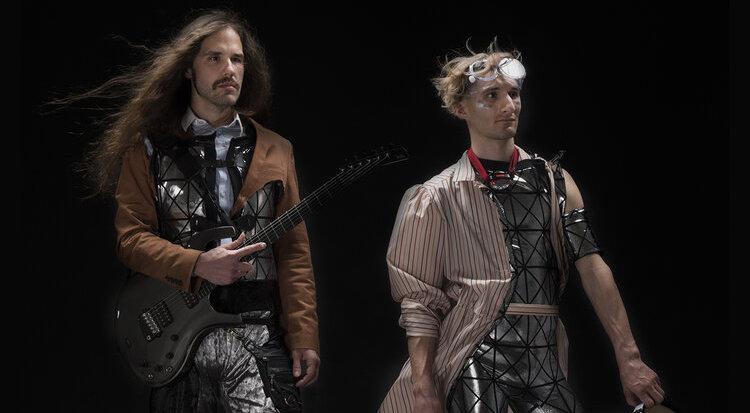
Sure enough, there are ups and downs. But Andrews attributes his and his partner’s compatibility to their differences: “I took a Myers-Briggs personality test 10 years ago. It was when Cambridge Analytica was putting all those things on Facebook to see which Harry Potter role you were. I hadn’t taken one since high school, and [Andy and I] did not have a single letter in common.
“I was an ISTJ: introverted, sensing, thinking, judging,” Andrews recalled, “and Andy was the opposite, ENFP [extroverted, intuitive, feeling, prospecting]. That explained a lot about what was going on in our dynamics, and we realized it was also a strength for us — that we approach things very differently. It has worked out. I get along with Andy better than I ever have. It’s a great thing personally and professionally.
“It would be the same,” the guitarist opined, “if you put two indoor cats together. They start hissing at each other because they’re very alike. I don’t think Andy and I would have been working together if we were alike. Andy fills in a lot of gaps for me in the way I think and see the world. I hope I do the same for him.”



